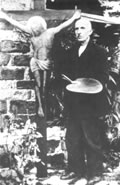|
 14/11/2006
14/11/2006
The origins of the art
The Chionades hagiographers constituted for a significant period of time under the Turkish occupation, as well as subsequently, one of the most numerous and enterprising teams of hagiographers, with a range that extended throughout the entire Balkans. In relation to the professional organisation and the teaching of the art in that area there are no written testimonies, a fact that has left the field open for all manner of suppositions.
 read more
read more
|
|
 14/11/2006
14/11/2006
Their organisation
Professional organisation and training in the art are inter-related under forms of artisan associations during the period of the Turkish occupation. Their common law dictated not only the conditions for the practice of the profession but also the conditions and the learning stages with the gradual assumption of even more responsibilities during the productive process.
 read more
read more
|
|
 14/11/2006
14/11/2006
The names of the Chionades hagiographers
The names of the Chionades hagiographers are so many in the age old tradition of this region, which has resulted in the folktale expression: «Are you from Chionades? Then youre a painter».
 read more
read more
|
|
 14/11/2006
14/11/2006
The orders for the works and their production
The teams, the «gangs» of tradesmen who undertook large buildings employed craftsmen with many specialisations. The view has remained that each of the craft villages specialised in either the design of buildings, producing bricklayers, decorators, marble carvers, carpenters, wood carvers and painters
 read more
read more
|
|
 14/11/2006
14/11/2006
The prices of their works
The remuneration for their work, as a rule, was handsome and the families of the painters were considered to be amongst the wealthiest. However, the scope for the development of their art and their personal style was not very broad, since the main focus of the project was determined by the clients and the thoughts on art that they hold.
 read more
read more
|
|
|
 14/11/2006
14/11/2006
Parallel works. Wood sculpture and decoration
However, the activities of the Chionades painters were also very significant in other forms of our folk art, such as wood sculpture. Fr. Georgios Paisios as well as the modern researchers have preserved many facts for us in relation to this art and its combination with painting
 read more
read more
|
|
 14/11/2006
14/11/2006
Their journeys
The extent of the activity by the Chionades painters is huge. Many of their journeys and the works that they have created during their period are known to us. These have been preserved for us in the main by the reverend Georgios Paisios and Mr. Kitsos Makris in their works that relate to the Chionades hagiographers, as well as by modern researchers.
 read more
read more
|
|
 14/11/2006
14/11/2006
The workshops and the apprenticeship
Mr. Kitsos Makris mentions that Mr. Socrates Zographos also maintained at the beginning of the 20th century a painting workshop at Ioannina with young apprentices. We may conclude from this that it would have been already operating in the last decade of the previous century, in order to be able to undertake more jobs simultaneously, as we have verified for example in 1892, where he needed many hands.
 read more
read more
|
|
 14/11/2006
14/11/2006
The sketches
Even the workshop sketches and the tracts were amongst the painters equipment. He would throw them into his knapsack and start on the road as soon as the weather cleared.
There are approximately 2000 Chionades workshop sketches surviving (draft work plans) in the collection of the Μ. and Β. Giannoulis family at Volos, some of which have been exhibited, further to their restoration, at a display in Volos, Thessalonike and Athe
 read more
read more
|
|
 14/11/2006
14/11/2006
The period of the rise and the fall of painting hagiography at Chionades
Through research to date, we are not aware of any works that we may attribute with certainty to the Chionades hagiographers in the 17th century. We have postulated their relation to the works in the broader region of the Mastrohorion villages that have survived and belong to that period, such as the chapel of Aghia Paraskevi at Langada, Aghios Athanasios at Theotokou or Aghios Nikolaos at Chionades.
 read more
read more
|
|
